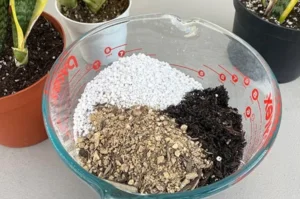Snake plants (Sansevieria) are known for their resilience and low maintenance, making them a favorite among plant enthusiasts. However, like all potted plants, they occasionally require repotting to continue thriving. Recognizing the right time to repot is essential to maintain the plant’s health. Here are the key signs that indicate your snake plant needs repotting.
1. Roots Growing Out of the Drainage Holes
One of the most obvious signs that your snake plant needs a new pot is when roots start emerging from the drainage holes at the bottom of the container. This indicates that the plant has outgrown its current space and is becoming root-bound.
2. Slow or Stunted Growth
If your snake plant’s growth has slowed down significantly despite proper care, it may be due to restricted root space. When the roots have no room to expand, they cannot absorb nutrients effectively, leading to slow or stunted growth.
3. Water Drains Too Quickly
When water passes through the soil too quickly and barely retains moisture, it might be a sign that the roots have taken up most of the space in the pot. Compacted roots leave little room for soil, which reduces water retention and can lead to dehydration.
4. Soil Decomposition or Poor Drainage
Over time, the potting mix can break down, losing its ability to drain properly. If you notice that the soil stays soggy for too long or dries out too quickly, it’s a sign that the mix has degraded and needs refreshing through repotting.
5. Leaves Turning Yellow or Wilting
Although snake plants are hardy, yellowing or wilting leaves can be a sign of stress. If your plant is in a cramped pot with depleted soil, it won’t get the nutrients it needs to stay healthy. Repotting can help revitalize its condition.
6. Cracks in the Pot or a Tightly Packed Root Ball
If you see cracks forming in a plastic pot or the plant pushing against the container walls, your snake plant is likely root-bound. In severe cases, removing the plant reveals a dense mass of roots circling around the pot with little soil left. This is a clear indication that it needs more space.
How to Repot a Snake Plant
Once you’ve identified the signs, follow these steps to repot your snake plant properly:
- Choose a New Pot – Select a pot that is one to two inches larger in diameter than the current one and has drainage holes.
- Prepare Fresh Soil – Use a well-draining potting mix, preferably one designed for succulents or cacti.
- Remove the Plant Carefully – Gently take the plant out of its current pot, loosening compacted roots if necessary.
- Place in the New Pot – Add fresh soil to the bottom of the new container, position the plant, and fill the sides with more soil.
- Water Lightly – Give it a small amount of water to help the soil settle, but avoid overwatering.
Conclusion
Repotting your snake plant at the right time is essential for its overall health and longevity. By recognizing signs such as root-bound conditions, poor soil quality, or slowed growth, you can ensure your plant continues to thrive. With proper repotting techniques and the right soil mix, your snake plant will remain a beautiful and resilient addition to your indoor space.






